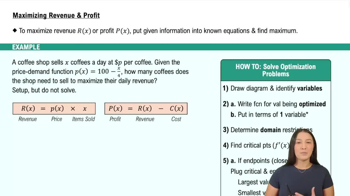Table of contents
- 0. Functions7h 52m
- Introduction to Functions16m
- Piecewise Functions10m
- Properties of Functions9m
- Common Functions1h 8m
- Transformations5m
- Combining Functions27m
- Exponent rules32m
- Exponential Functions28m
- Logarithmic Functions24m
- Properties of Logarithms34m
- Exponential & Logarithmic Equations35m
- Introduction to Trigonometric Functions38m
- Graphs of Trigonometric Functions44m
- Trigonometric Identities47m
- Inverse Trigonometric Functions48m
- 1. Limits and Continuity2h 2m
- 2. Intro to Derivatives1h 33m
- 3. Techniques of Differentiation3h 18m
- 4. Applications of Derivatives2h 38m
- 5. Graphical Applications of Derivatives6h 2m
- 6. Derivatives of Inverse, Exponential, & Logarithmic Functions2h 37m
- 7. Antiderivatives & Indefinite Integrals1h 26m
- 8. Definite Integrals4h 44m
- 9. Graphical Applications of Integrals2h 27m
- 10. Physics Applications of Integrals 2h 22m
5. Graphical Applications of Derivatives
Applied Optimization
Problem 70
Textbook Question
The ladder problem What is the approximate length (in feet) of the longest ladder you can carry horizontally around the corner of the corridor shown here? Round your answer down to the nearest foot.
 Verified step by step guidance
Verified step by step guidance1
Visualize the problem as a right-angled triangle where the ladder forms the hypotenuse, and the two legs are the widths of the corridors. Let the widths of the corridors be 'a' and 'b'.
Use the Pythagorean theorem to express the length of the ladder (hypotenuse) in terms of 'a' and 'b'. The equation is: <math xmlns="http://www.w3.org/1998/Math/MathML"><mi>c</mi><mo>=</mo><msqrt><msup><mi>a</mi><mn>2</mn></msup><mo>+</mo><msup><mi>b</mi><mn>2</mn></msup></msqrt></math>.
To find the maximum length of the ladder that can be carried horizontally, consider the geometry of the corner. The ladder must touch both walls at the corner, forming a right triangle with the corner.
Set up an equation for the ladder's length in terms of the angle it makes with one of the walls. Use trigonometric identities to express the length in terms of sine and cosine: <math xmlns="http://www.w3.org/1998/Math/MathML"><mi>L</mi><mo>=</mo><mfrac><mi>a</mi><mrow><mi>sin</mi><mo>⁡</mo><mi>θ</mi></mrow></mfrac><mo>+</mo><mfrac><mi>b</mi><mrow><mi>cos</mi><mo>⁡</mo><mi>θ</mi></mrow></mfrac></math>.
Differentiate the expression for 'L' with respect to the angle <math xmlns="http://www.w3.org/1998/Math/MathML"><mi>θ</mi></math> and find the critical points to determine the maximum length of the ladder. Use the first or second derivative test to confirm the maximum.
 Verified video answer for a similar problem:
Verified video answer for a similar problem:This video solution was recommended by our tutors as helpful for the problem above
Video duration:
13mPlay a video:
Was this helpful?
Key Concepts
Here are the essential concepts you must grasp in order to answer the question correctly.
Optimization
Optimization in calculus involves finding the maximum or minimum values of a function. In the context of the ladder problem, we need to determine the longest ladder that can fit around a corner, which requires setting up a function that describes the relationship between the ladder's length and the dimensions of the corridor.
Recommended video:

Intro to Applied Optimization: Maximizing Area
Geometric Relationships
Understanding geometric relationships is crucial for solving the ladder problem. This involves visualizing the ladder as a hypotenuse of a right triangle formed by the corridor's walls and applying the Pythagorean theorem to relate the lengths of the sides to the ladder's length.
Recommended video:

Derivatives Applied To Velocity
Calculus of Functions
The calculus of functions, particularly derivatives, is essential for finding critical points where the maximum length of the ladder occurs. By differentiating the function that models the ladder's length with respect to its position, we can identify the optimal length that satisfies the constraints of the corridor.
Recommended video:

Fundamental Theorem of Calculus Part 1

 1:13m
1:13mWatch next
Master Intro to Applied Optimization: Maximizing Area with a bite sized video explanation from Callie
Start learningRelated Videos
Related Practice








